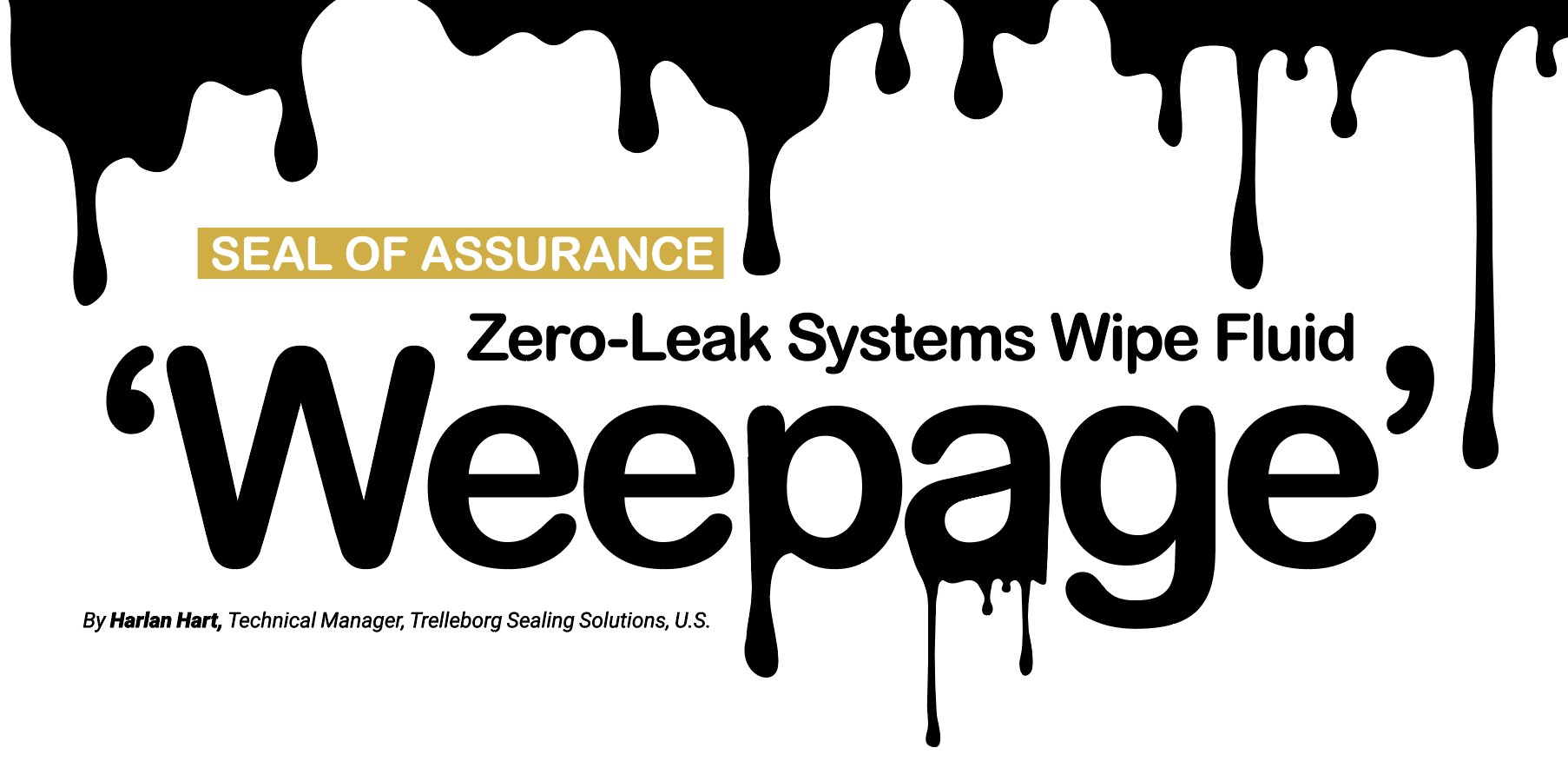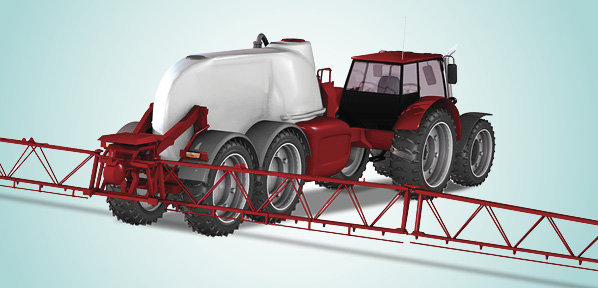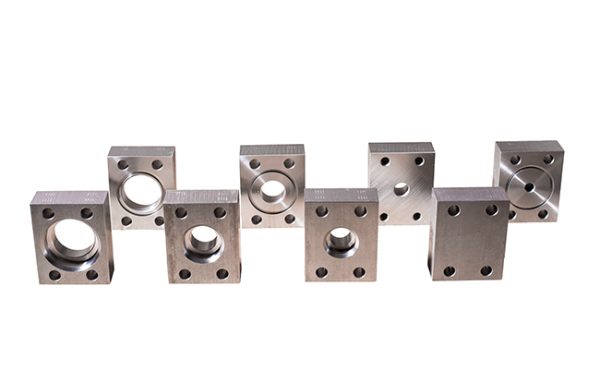Seal of Assurance: Zero-Leak Systems Wipe Fluid ‘Weepage’

By Harlan Hart, Technical Manager, Trelleborg Sealing Solutions, U.S.
A variety of factors, such as a desire for higher efficiency, are driving manufacturers and hydraulic equipment operators toward robotic equipment. Agricultural robots, including tillers, harvesters, weed sprayers, and pruners, have led the way. But robots for assembly lines and warehouses are quickly gaining traction.
Assembly and transport robots used in manufacturing and warehousing operations usually combine hydraulic systems with electric or pneumatic ones. The reason for this is the weight of the loads.
Although electric systems eliminate the need for hydraulic fluid and generate more accurate motion, they can’t compete with hydraulic systems when the task involves moving heavy loads repeatedly for long periods, which is often the case in automotive and other heavy-equipment manufacturing.
Manufacturers, therefore, turn to hybrid robots in which hydraulics do the heavy lifting and an electric or pneumatic system does the clamping and holding. Being more easily retooled and repositioned, the electrics and pneumatics also increase system flexibility.
Hybrid hydraulic and electrical designs require special care when specifying hydraulic sealing systems because weepage of even a light coating of hydraulic fluid can negatively affect an electrical system’s performance, while indoor environmental factors, such as humidity and dust, can be detrimental to the operation of hydraulic systems.
But as this article shows, the design of systems in hybrid robots can reduce aerosolization of hydraulic fluid and mitigate the effects of humidity, ozone, and dust in the environment.
Preventing weepage
In traditional hydraulic systems, including many current agricultural applications, a small amount of fluid escape from hydraulic cylinders is acceptable. This is referred to as “weepage” to distinguish it from a fluid drip that indicates a leak. In hybrid robots, however, weepage can be problematic.
The solution to this issue is an extremely robust zero-leakage sealing system. These systems prevent hydraulic weepage from becoming aerosolized and coating the electric components of the robot or escaping into an environmentally sensitive area.
Zero-leakage sealing systems employ a highly sophisticated form of lubrication management that ensures the rod remains properly lubricated but reduces or eliminates weepage. The systems typically consist of two or three elastomer slipper seals that keep the shaft dry on the outside, while properly lubricating the shaft to ensure performance and durability.
Wipers and bearings
Zero-leakage sealing systems frequently contain a single- or double-acting wiper. A single-acting wiper wipes off the rod as it re-enters the system to prevent contaminants from entering the back-pumping area of the system. A double-acting wiper, in addition to wiping the rod, contains a U-cup seal to trap the small amount of fluid that may escape from the seal in front of it, keeping it in the system.
Good zero-leakage systems also employ bearings to improve alignment, relieving the seals of this function. The bearings enable the seals to function more efficiently and are often used in systems in which load or side load are a factor. For example, a sealing configuration located at the end of a rod cylinder might consist of a U-cup seal, bearing, polytetrafluoroethylene (PTFE) seal, another bearing, and a final seal. The bearings ensure proper alignment, enabling the seals to remain centered and provide maximum sealing effect.
Indoor environments
For hybrid robots designed to operate indoors, humidity is problematic when levels are high enough to cause moisture to collect and enter the system. Water can quickly contaminate hydraulic fluid, potentially causing system failure.
The solution to this is two-fold.First, a high-quality, durable wiper will keep out as much moisture as possible. Second, if possible, a change to the system orientation will reduce the chance that water pools on the rod. To ensure hydraulic-fluid drainage in a vertical hydraulic system, rather than the rod exiting the system at the top, the rod should be oriented to exit at the bottom.
If reorienting the rod is not an option, consider specifying a specialized wiper designed to push water away from the rod. In this case, the moisture that collects and drips down the shaft hits the wiper and deflects away from the system.
Environments like warehouses are extremely dusty, and dust can potentially contaminate a hydraulic system to the point of performance reduction or failure. Robots picking inventory from shelves, placing boxes on pallets, or transporting pallets are especially susceptible to dust-related issues.
A double-wiper sealing system containing standard pressure seals with a wiper, then an auxiliary cap with a second wiper, can mitigate such issues. Designed to be a robust initial barrier to ingress of dust, the second wiper does not contain a lip to retain fluid. Any small amount of fine dust particles getting past this wiper and entering the system are then cleared by the inner wiper.
Selecting seal material
Mitigating the effects of ozone is a matter of careful seal-material selection. Even in small amounts, ozone can cause rubber seals to crack. If a hybrid robot is exposed to ozone (e.g., from a nearby welding operation), choose an ozone-resistant material such as ethylene propylene diene methylene or fluorocarbon to prevent ozone damage.
Stick slip may occur in hydraulic systems running at low speeds. Therefore, hybrid robots designed to perform short, precise movements at slow speed may encounter this phenomenon. Using PTFE seals rather than rubber can alleviate this issue because of their low-friction attributes.
Some hybrid robots require an alternative to traditional hydraulic fluid. For example, a robot performing a mining task near a river or other water source requires a biodegradable fluid to eliminate the possibility of hydraulic fluid entering the water in the event of a catastrophic failure. These environmentally friendly fluids need chemically compatible sealing to prevent premature wear or even failure. Sealing suppliers can help recommend the appropriate seal material for such applications.
Although electrical systems can be extremely advanced and play an important role in robotic equipment, hydraulic systems are still the best solution for consistently moving heavy loads.
Zero-leakage sealing systems are key to preventing small amounts of hydraulic fluid emission during a robot’s operation. This fluid can become aerosolized and cause damage or other issues of accuracy, quality, or performance by coating nearby electronic components. Specialty sealing configurations can ensure water and dust do not contaminate the hydraulic system.
Designers should consult with their seal suppliers about material and seal selection to achieve the ideal combination of seals, wipers, and bearings to maximize the performance of a hybrid robot.







